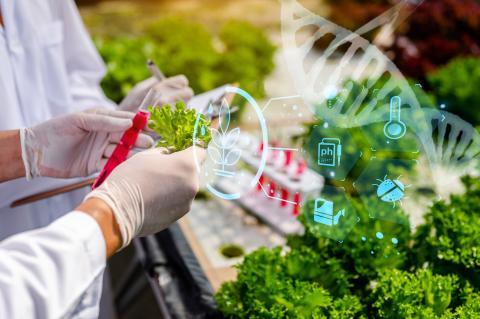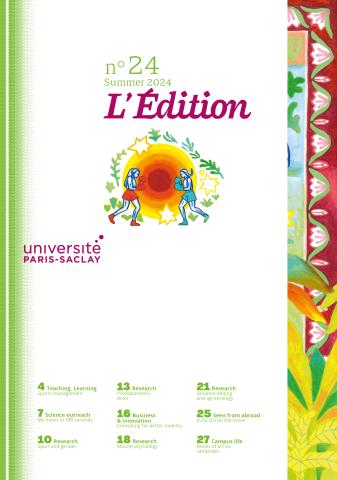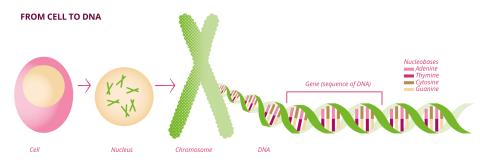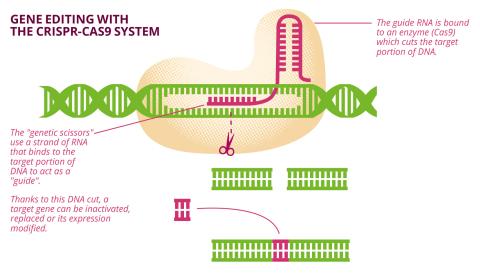
Genome editing and agroecology: a combination that is proving beneficial
This article was originally published in L'Édition n.24.
To cope with both rising food demand and climate change, agriculture needs to make the transition to agroecology. However, the selection of useful plants for the agroecological transition is based on different criteria, too often neglected in the past, as opposed to yield, long favoured in agriculture. The result today is a lack of genetic diversity in agricultural plants for these traits of interest. To re-establish variety on targeted genes and obtain plant species beneficial to the agroecological transition as quickly as possible, scientists are now using new genomic techniques, based in particular on CRISPR/Cas9 molecular scissors.
Agriculture in the 21st century faces the dual challenge of feeding an ever-growing world population, while at the same time standing up to the numerous challenges posed by climate change and other factors. To achieve this, today’s agricultural system has to reinvent itself in order to continue producing while at the same time preserving natural resources. This is what agroecology is all about. In this new farming paradigm, the resources of biodiversity are used to reduce the employment of chemical inputs and avoid soil and water pollution. Plants are grown in association with other living beings: hedges, bacteria, fungi and service plants. The result is greater resistance to the various stresses to which the crop is subjected: bad weather, drought, pests and diseases.
Using genomics to produce plants with novel traits
Agroecology requires a detailed knowledge of the associations that can be made between plants and other organisms (such as other plants or soil bacteria). We also need to discover new associations. This requires a wide diversity of plants expressing a variety of different characteristics in terms of growth cycle, soil cover, weather resistance, and so on. And yet until now, agriculture has mainly selected plants for their yield, leading to low species diversity. "Plants used in agriculture today are relatively poor in terms of the diversity of traits useful for agroecology," states Fabien Nogué, a researcher at the Jean-Pierre Bourgin Institute (IJPB - Université Paris-Saclay/AgroParisTech/INRAE). "The agroecology prism thus brings in new goals, which are sought during the selection process."
The characteristics expressed by a plant, such as its size, growth speed and leaf shape, are all encoded in its DNA. This long molecule, housed in the cell nucleus, has a double helix structure and is made up of a series of smaller molecules: nucleotides. Nucleotides are formed from four different bases: adenine (A), cytosine (C), guanine (G) or thymine (T). The sequence of these nucleotides forms a code, which is then translated by the cell to produce molecules fulfilling various functions: proteins. It is the expression of these proteins that gives the plant its apparent characteristics, the so-called phenotype.
The term "gene" refers to a segment of DNA that codes for a protein. The same gene exists in different versions, called "alleles". "Alleles give rise to proteins with certain subtle differences, which confer different functions," says the researcher. For a given trait, different alleles result in different phenotypes. If we understand which gene is responsible for a particular trait, and if we are able to modify that gene, it then becomes possible to modify that trait in plants.
New, more natural genomic techniques
New genomic techniques (NGT) make this possible. These techniques are based on the use of "molecular scissors" such as the CRISPR-Cas9 system. "This system is capable of generating a break in DNA at a given nucleotide sequence," explains Fabien Nogué. "Cells have a molecular machinery capable of repairing this break. However, in some cases, this repair results in a modification of the DNA sequence": a mutation has occurred. By applying these techniques, we obtain an individual whose genome has been edited, resulting in a different expression of the targeted trait.
Similar to a genetically modified organism (GMO), i.e. an organism whose genetic make-up has been altered in order to acquire new properties, an NGT-modified organism is nevertheless different from a transgenic organism. Mutations obtained by NGT are indistinguishable from natural mutations, whereas so-called "conventional" (transgenic) GMOs are obtained by transferring a gene that may have originated in a different species. With NGTs, the only modifications made to the genome are deletions, insertions or the substitution of one or more nucleotides.
These mutations also occur naturally during cell division, or as a result of external factors such as exposure to the sun. Although these events are rare on the scale of the cell, they become commonplace when aggregated across all living organisms. "We estimate that each base pair in the tomato genome is naturally mutated fifty times if we take into account all the tomatoes produced each year," says Fabien Nogué.
It is this process of mutation that results in the diversity of living organisms. By making it possible to carry out mutations similar to natural mutations, but targeting mutated genes, NGTs accelerate this diversification of living organisms on traits of interest. "In some cases, NGTs are creating varieties that make sense in terms of reducing inputs", says the biologist, who was quick to seize on CRISPR-Cas9 technology for his research.
"When CRISPR-Cas9 came along, all of a sudden I had a tool that let me induce mutations at a chosen point in the genome. I then turned my attention to the possible applications of this tool. Together with colleagues, we have carried out NGT proofs of concept on various different species. For example, we have created a tomato variety that expresses the same resistance to a virus as a pepper," explains Fabien Nogué, who has also been an expert on the GMO panel of the European Food Safety Authority (EFSA) since 2015.
The virtues of the camelina-lentil combination
Jean-Denis Faure, also a researcher at the IJPB and professor at AgroParisTech, is also working on plant varieties for agroecology. This professor of physiology devotes his work to the camelina, a plant cultivated in Europe up until the early 20th century, and which is now attracting renewed interest as part of an agroecological transition. "It’s a plant that tolerates various different stresses, and its short cycle means it can be grown in a variety of different conditions. What’s more, it has a particularly rigid bearing," explains the scientist. This particular trait is of interest for other plants with a more flexible habit, such as lentils. "If there are heavy showers, the lentils are washed onto the ground. It is then vulnerable to fungus and rot." A few camelina plants in a lentil field act as stakes, making the crop more resistant to bad weather.
The combination of lentils and camelina could be even more advantageous. "Lentils are often attacked by bruchids. These tiny insects bore into the seeds, making them unusable. This is a real problem in Protected Designations of Origin (PDOs), where the choice of varieties grown is limited. Camelina, like cabbage- type plants, emits volatile sulphur molecules, which are insect repellents," explains Jean-Denis Faure, who plans to study this plant association in greater depth.
According to this researcher, virtuous exchanges also occur in the other direction. Lentils are in fact a legume. This family of plants has the ability to capture nitrogen through symbiosis with bacteria. Nitrogen is essential for plant growth, as it is a component of protein amino acids. "Lentils could provide camelina with some nitrogen, resulting in an extremely virtuous system," says Jean-Denis Faure. The nitrogen provided by lentils would at least partially replace artificial fertilizers.
NGTs to reduce inputs while preserving profitability
According to Fabien Nogué, the combination of nitrogen-capturing legumes with plants of interest is being considered in many other cases, notably with wheat and corn. "The difficulty at the moment is that legumes and wheat or corn grow differently and therefore have different harvest times." Up to now, harvesting time was not one of the criteria selected for legumes. But with NGTs, researchers hope to obtain varieties whose growth is compatible with wheat or corn cultivation. "The idea is that combining plants should be just as profitable for the farmer as monoculture," Fabien Nogué emphasises.
To encourage farmers to diversify their crops, scientists are also working on diversity of use. Due to lower yields, camelina, for example, is not as economically attractive today as other intensively cultivated species such as rapeseed. However, "the first thing a farmer looks at when choosing a species to grow is whether he get value from it," explains Jean-Denis Faure. To overcome this obstacle, the IJPB researcher focuses on using NGTs to drive the plant to express new traits, for example by modifying the nature of the oil produced so that it finds new uses.
Another goal of agroecology is to reduce the use of herbicides. One of the strategies envisaged is the use of more covering plants that develop a vegetation cover in the early stages of their growth, thereby limiting weed growth. This strategy requires plant varieties that produce broad basal leaves as soon as they germinate. But then again, "these are not characteristics that have been worked on to date. Current varieties don’t meet these needs," points out Fabien Nogué. Hence the interest of NGTs in restoring diversity to traits that have disappeared or have not yet been worked on.
More scientific challenges
However, "NGTs shouldn’t be seen as a panacea," says Fabien Nogué. "These techniques are not the death knell of conventional selection." Their main limitation lies in the fact that, without detailed knowledge of the genes encoding each trait, genome editing cannot be used to give the plant a specific trait. For example, not all the genes responsible for symbiosis between legumes and nitrogen-fixing soil bacteria have been identified yet. "We can’t explain this phenomenon by naming ten important genes and the order in which they are expressed," says the researcher. We’ll have to wait a little longer before we can obtain new plant species capable of this symbiosis as quickly as we would wish.
References:
- F. Nogué et al., Can genome editing help transitioning to agroecology? iScience 27, 109159, March 15, 2024.
- Y. Bellec et al., New Flowering and Architecture Traits Mediated by Multiplex CRISPR-Cas9 Gene Editing in Hexaploid Camelina sativa. Agronomy 12, 1873, 2022.
Co-design: a new scientific method?
Despite the power of new genome-editing techniques (NGTs), their relevance to agroecological transitions remains open to debate. In order to develop innovations that best meet the challenges of these transitions, scientists are experimenting with a new way of managing their research: co-design. This involves working together across disciplines and with a variety of different players to build up research issues that best take into account the needs of the different stakeholders.
While genome editing is a powerful tool that can be mobilised to support the agroecological transition, experience with GMOs calls for a certain caution when it comes to the promises made on behalf of NGTs. Firstly, it is highly likely that such technologies alone will not solve the world’s hunger problems. Secondly, the real capacity of GMOs to reduce the inputs (fertilizers, pesticides, etc.) used in agriculture remains controversial. As a result, the scientific community is wondering how to position itself on such research topics while driving sustainable progress.
To respond to major and complex societal challenges in a wide variety of fields, such as hunger and the preservation of biodiversity, academic research is increasingly adopting a new modus operandi: co-design. Researchers are often experts in one particular field of research, working on issues at the cutting edge of that field - enabling progress towards ever richer and more solidly established knowledge. However, this usual mode of operation in academic research comes up against certain limits when it comes to proposing solutions to problems that combine very different aspects.
Co-design provides a striking contrast to this. A research project is usually defined in advance, with a precise problem to which it seeks to respond; resources are then allocated for a certain duration, and at the end of the project, the participants all meet to take stock of the initial question. Co-design, however, overturns this established order - the research question is not defined beforehand and the project begins with the various players.
Genetics and agronomy: bringing together distant scientific interests through co-design
As part of the France 2030 research programme "Advanced Plant Science for Climate Change and Agroecological Transition" (SVA in French), Jean-Denis Faure, a researcher at the Jean-Pierre Bourgin Institute (IJPB - Université Paris-Saclay/AgroParisTech/INRAE), is responsible for defining strategies for an agroecological transition based on genome editing. Such a project requires the involvement of a wide range of specialists, not just geneticists, but also agronomists specialising in agroecology. But given the differing concerns of all these research communities, defining a common research project to rally around can sometimes prove difficult.
"This is particularly true when we try to combine genetics and agroecology," concedes Julie Labatut, a researcher in Management sciences at the Animal Genetics and Integrative Biology laboratory (GABI - Univ. Paris-Saclay/INRAE/ AgroParisTech) with which Jean-Denis Faure is currently collaborating. "Geneticists and agronomists are opposed in their methods, their goals and their visions of innovation." Agronomy focuses on farmers’ practices and on interactions between farms at the territorial level, i.e. on a macroscopic scale, whereas genetics is concerned with the microscopic. "After a year and a half’s work, I hadn’t come up with a satisfactory project," confides Jean-Denis Faure. Today, with Julie Labatut and other scientists from different disciplines, he is working to set up a co-design process as part of the SVA programme.
Applying a management science method
This work will take place over several years. The first year will be devoted to defining a common research question. "We plan to bring together around thirty participants over several days, using the Knowledge, Concepts, Propositions (KCP) method," explains Julie Labatut. This method was designed for companies looking to innovate, although for several years now, Julie Labatut has been applying it to agricultural issues.
In the first phase of the KCP method, people share their knowledge. They then generate new concepts based on this shared knowledge. The final step in the KCP method is to write down proposals based on these concepts. The proposals form the research question on which the project will focus. This method aims to widen the field of possibilities by helping to co-design new research issues.
It was in the Basque Country that Julie Labatut first applied the KCP method to an agricultural problem. The black head Manech sheep, a breed of ewe whose milk is used to make Ossau-Iraty cheese, was competing with more productive breeds of sheep. Using the KCP method, the researcher brought together breeders unfamiliar with genetic selection and geneticists unfamiliar with the importance of the shape of a ewe’s horns. "Over a period of ten years we brought together people who had never spoken to each other before, to develop an innovative breeding programme," says Julie Labatut.
Towards a redefinition of scientific goals for innovation closer to the challenges of sustainability
Will co-design make it possible to combine state-of-the-art genetics and agroecology? According to Julie Labatut and Jean-Denis Faure, this will also require a change in the definition of scientific goals. "We need to move from an economy of promise to an economy of impact," confides the researcher. This means developing methods and criteria for evaluating innovation coming out of the laboratories in real time, rather than promising new, better-performing plant varieties.
Understanding the real interest of a new plant species for farmers, and its impact on the agroecological transition, is a whole research project in itself. Its impact on the environment is very diverse, and its behaviour in the field is sometimes very different from in the laboratory. "The socio-economic impact, in terms of innovation governance, socio-technical barriers and long-term benefits, has to be assessed along the way," emphasises Julie Labatut.
To ensure that genome editing and agroecology progress hand in hand, scientists in the SVA programme will be mobilising co-design approaches and real-time socio-economic impact analysis right from the start of their research. Researchers will thus ensure that their work is as close as possible to the real needs of the different farmers and the challenges of agroecological transition. The hope is that this innovation will eventually leave the laboratory and be applied in the field.
References:
- J. Labatut, S. Hooge. Renouveler la gestion de ressources communes par la conception innovante ? Le cas d’une race locale au Pays basque. Natures Sciences Sociétés, 24(4), p. 319-330, 2016.
- M. Matt et al., ASIRPA Real Time in the making or how to empower researchers to steer research towards desired societal goals. Research Evaluation, 32(2), p.412-425, 2023.

This article was originally published in L'Edition No. 24.
Find out more about the journal in digital version here.
For more articles and topics, subscribe to L'Édition and receive future issues:
Subscribe


